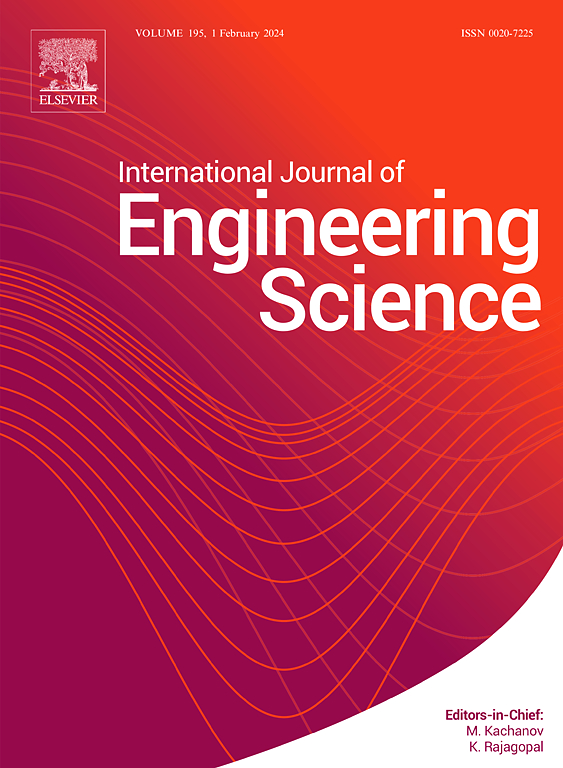A phantom-chain based viscoplastic model for local relaxation of magneto-active polymer composites under dynamic magnetic field
IF 5.7
1区 工程技术
Q1 ENGINEERING, MULTIDISCIPLINARY
International Journal of Engineering Science
Pub Date : 2025-03-24
DOI:10.1016/j.ijengsci.2025.104252
引用次数: 0
Abstract
Magneto-active polymer composites (MAPCs) can change their mechanical properties (i.e., stiffness) and/or mechanical deformation upon an external magnetic stimulus. The mechanical response of MAPCs is primarily determined by the interaction between the polymer matrix and magnetic particles, alongside the performance of the constituent materials. When a directional dynamic magnetic field is applied, mainly two types of relaxation behavior occur due to magnetic particle oscillations and rotations, i.e., heat-generation caused phase change and viscosity reduction, and chain cleavage and de-adhesion from particles. This material relaxation caused by local chain debonding is fundamentally different from that by the phase transition characterized with variation of free volumes. This work proposes a phantom-chain based magnetomechanical model to reflect magnetic particles oscillating caused local material relaxation, and a Maxwell rheological model is superimposed to capture the heat-triggered relaxation behavior of MAPCs under dynamic magnetic field. Considering changes in the chain configuration, a phantom-chain model is constructed by wave-propagation modeling and further integrated through full network space to capture the overall magnetomechanical properties of MAPCs. The magnetic field triggered heat-generation is simulated by both Brownian relaxation and Neel relaxation. The model is calibrated through a series of tests and then applied in simulations of the isothermal uniaxial tension of MAPCs, both with and without external magnetic fields. These simulations show the model's effectiveness in capturing the material relaxation behavior of MAPCs under dynamic magnetic activation. Good agreement between the simulations and experiments demonstrates the validation and effectiveness of the proposed model and solution procedure. The calibrated model is further applied to the multi-cycle shape memory modeling of MAPCs under the alternating magnetic field. This work lays a theoretical foundation and contributes to the design and widespread application of 3D complex microstructured MAPCs.
动态磁场作用下磁活性聚合物复合材料局部弛豫的一种基于幻影链的粘塑性模型
磁活性聚合物复合材料(MAPCs)可以在外部磁刺激下改变其机械性能(即刚度)和/或机械变形。MAPCs的机械响应主要取决于聚合物基质和磁性颗粒之间的相互作用,以及组成材料的性能。当施加定向动态磁场时,由于磁粒子的振荡和旋转,主要发生两种类型的松弛行为,即产生热量引起的相变和粘度降低,以及颗粒的解链和脱粘。这种由局部链脱键引起的材料弛豫与以自由体积变化为特征的相变引起的材料弛豫有着根本的区别。本文提出了一个基于幻影链的磁力学模型来反映磁粒子振荡引起的局部材料弛豫,并叠加了一个麦克斯韦流变模型来捕捉动态磁场下MAPCs的热触发弛豫行为。考虑到磁链构型的变化,通过波传播建模构建幻链模型,并通过全网络空间进行整合,以获取MAPCs的整体磁力学特性。用布朗弛豫和尼尔弛豫模拟了磁场触发的热生成过程。该模型通过一系列测试进行了校准,然后应用于有和没有外加磁场的MAPCs的等温单轴张力模拟。这些模拟结果表明,该模型能够有效地捕捉动态磁激活下MAPCs的材料弛豫行为。仿真结果与实验结果吻合良好,验证了所提模型和求解过程的有效性。将校正后的模型进一步应用于交变磁场下MAPCs的多周期形状记忆建模。该工作为三维复杂微结构MAPCs的设计和广泛应用奠定了理论基础。
本文章由计算机程序翻译,如有差异,请以英文原文为准。
求助全文
约1分钟内获得全文
求助全文
来源期刊

International Journal of Engineering Science
工程技术-工程:综合
CiteScore
11.80
自引率
16.70%
发文量
86
审稿时长
45 days
期刊介绍:
The International Journal of Engineering Science is not limited to a specific aspect of science and engineering but is instead devoted to a wide range of subfields in the engineering sciences. While it encourages a broad spectrum of contribution in the engineering sciences, its core interest lies in issues concerning material modeling and response. Articles of interdisciplinary nature are particularly welcome.
The primary goal of the new editors is to maintain high quality of publications. There will be a commitment to expediting the time taken for the publication of the papers. The articles that are sent for reviews will have names of the authors deleted with a view towards enhancing the objectivity and fairness of the review process.
Articles that are devoted to the purely mathematical aspects without a discussion of the physical implications of the results or the consideration of specific examples are discouraged. Articles concerning material science should not be limited merely to a description and recording of observations but should contain theoretical or quantitative discussion of the results.
 求助内容:
求助内容: 应助结果提醒方式:
应助结果提醒方式:


